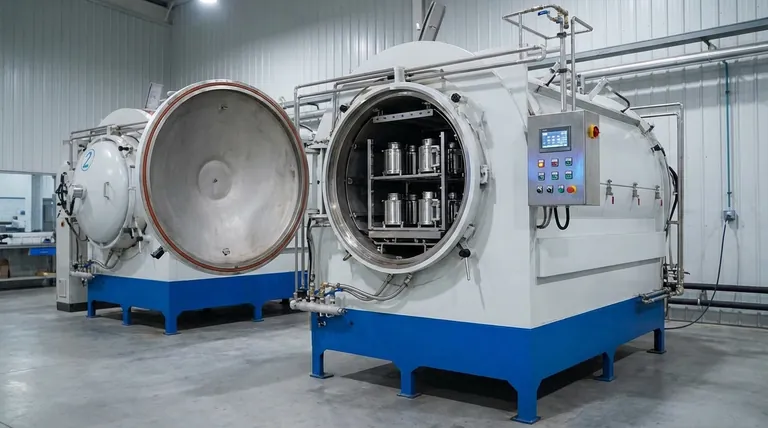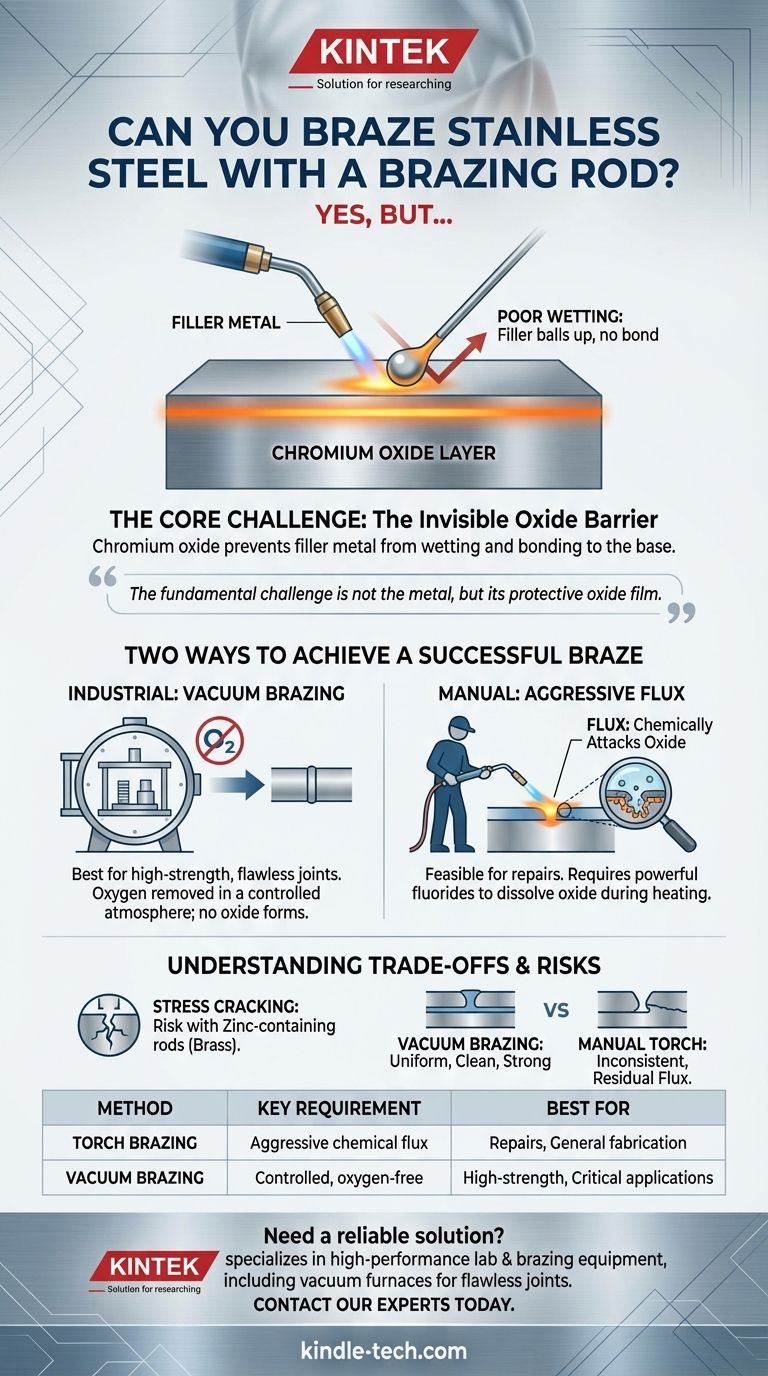Yes, you can braze stainless steel with a brazing rod, but it is significantly more challenging than brazing common metals like copper or mild steel. The success of the operation depends entirely on overcoming the tough, invisible layer of chromium oxide on the steel's surface, which prevents the filler metal from properly wetting and bonding to the parent material.
The fundamental challenge in brazing stainless steel is not the metal itself, but its protective oxide film. This layer must be either chemically removed with a powerful flux or prevented from forming in a controlled atmosphere for a successful joint to be made.

The Core Challenge: Stainless Steel's Protective Oxide Film
Brazing works by creating a metallurgical bond between a filler metal and the base metals. For this to happen, the filler must be able to "wet" the surface, meaning it flows smoothly and adheres to it. The oxide layer on stainless steel directly prevents this.
What is the Oxide Layer?
Stainless steel's corrosion resistance comes from a high chromium content. This chromium reacts with oxygen in the air to form a very thin, dense, and stable layer of chromium oxide.
This layer is self-healing and protects the steel from rust and corrosion, but it is a major obstacle for brazing.
Why It Prevents a Proper Braze
The brazing filler metal cannot bond with the oxide layer; it must bond with the pure stainless steel underneath. The oxide film acts as a barrier, preventing the filler metal from making intimate contact.
This results in poor wetting, where the filler metal balls up and refuses to spread, creating a weak or nonexistent joint.
How to Achieve a Successful Braze
To braze stainless steel, you must remove the oxide layer and keep it from re-forming as you heat the joint. There are two primary ways to accomplish this, typically defined by the scale and precision of the work.
The Industrial Standard: Vacuum Brazing
For high-strength, aesthetically perfect joints in industrial settings, vacuum brazing is the preferred method.
The parts are assembled with the filler metal and placed inside a furnace. Air is pumped out to create a vacuum, which effectively removes the oxygen. As the part is heated, any existing oxide layer breaks down, and no new oxide can form, allowing the filler metal to flow perfectly.
The Manual Method: Aggressive Chemical Flux
When using a torch and a brazing rod, you must rely on a chemical flux to manage the oxide layer.
Fluxes for stainless steel are much more aggressive than standard brazing fluxes. They contain powerful fluorides that chemically attack and dissolve the chromium oxide layer as the part is heated, exposing the clean metal underneath for the brazing alloy to bond with.
Understanding the Trade-offs and Risks
While possible, manual brazing of stainless steel comes with specific challenges that must be managed to avoid failure.
The Risk of Stress Cracking
Certain types of stainless steel, particularly austenitic grades (like 304 or 316), are susceptible to stress cracking during the brazing process.
This risk is especially high when using filler metals containing zinc, such as common copper-zinc (brass) brazing rods. The combination of thermal stress and the filler metal can cause microscopic cracks to form in the base metal, compromising the joint's integrity.
Joint Strength and Aesthetics
A major trade-off is the final quality of the joint. Vacuum brazing produces exceptionally clean, strong, and uniform joints because the process is perfectly controlled.
Manual torch brazing, even with the correct flux and technique, can be less consistent. It is difficult to heat the part evenly, and residual flux must be thoroughly cleaned post-braze to prevent corrosion, which can be a difficult process.
Making the Right Choice for Your Application
Your approach should be dictated by the demands of your project.
- If your primary focus is maximum strength and a flawless finish: Professional vacuum brazing is the only reliable method for critical applications like aerospace or medical devices.
- If your primary focus is a functional repair or general fabrication: Torch brazing with a rod is feasible, but you must use a specialized flux for stainless steel and carefully consider a compatible filler metal (often a silver-based alloy) to avoid issues like stress cracking.
Ultimately, successful brazing on stainless steel is a matter of absolute control over its protective oxide surface.
Summary Table:
| Method | Key Requirement | Best For |
|---|---|---|
| Torch Brazing (with Rod) | Aggressive chemical flux | Repairs, general fabrication |
| Vacuum Brazing | Controlled, oxygen-free atmosphere | High-strength, critical applications |
Need a reliable solution for your stainless steel brazing project?
Brazing stainless steel requires precision and the right equipment to ensure a strong, durable bond. KINTEK specializes in high-performance lab and brazing equipment, including vacuum furnaces ideal for achieving flawless, industrial-grade joints without oxidation.
Whether you're in aerospace, medical device manufacturing, or general fabrication, our expertise can help you overcome the challenges of brazing stainless steel. Contact our experts today to discuss your specific needs and discover how KINTEK's solutions can enhance your process and results.
Visual Guide

Related Products
- Vacuum Heat Treat Sintering Brazing Furnace
- Vacuum Heat Treat Furnace with Ceramic Fiber Liner
- Vacuum Heat Treat Furnace and Levitation Induction Melting Furnace
- Molybdenum Vacuum Heat Treat Furnace
- 2200 ℃ Tungsten Vacuum Heat Treat and Sintering Furnace
People Also Ask
- What is the difference between welding and vacuum brazing? Choose the Right Joining Method for Your Project
- What is the process of a vacuum furnace? Achieve Purity and Precision in High-Temp Processing
- What are the different types of brazing welding? A Guide to Choosing the Right Heat Source
- Can dissimilar metals be brazed or braze welded? A Guide to Strong, Reliable Joints
- Where are vacuum furnaces used? Essential for High-Purity Heat Treatment in Critical Industries



















